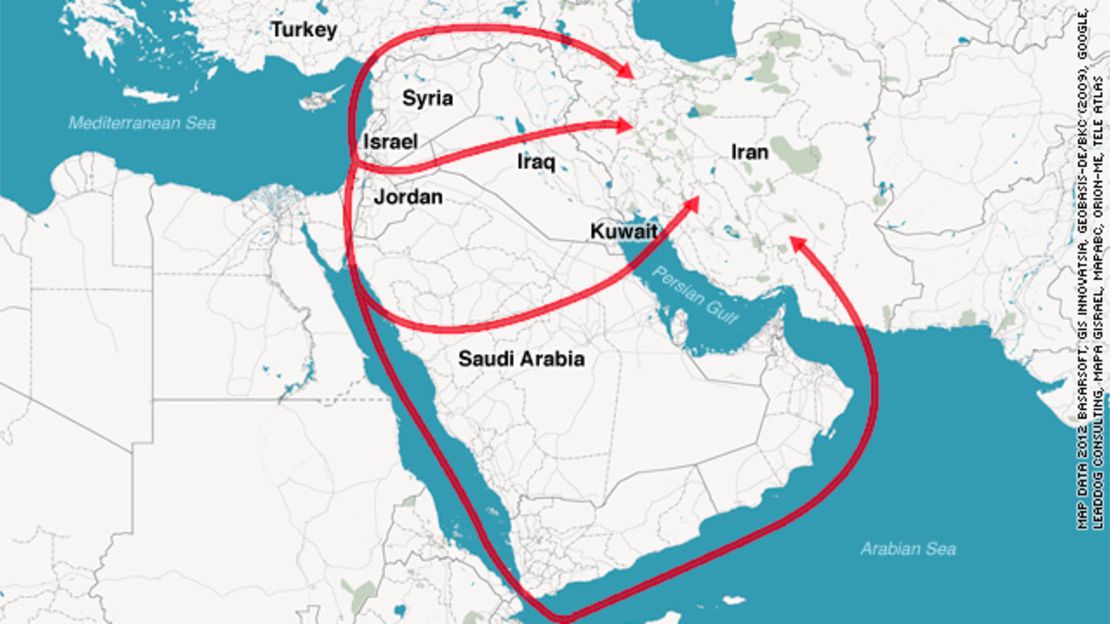
Kenan Camurcu
After Khamenei's "axis of resistance" officials and proxies like Hamas and Hezbollah were eliminated, Israel for the first time took direct action against the Iranian regime. Flying 20 warplanes into Iranian airspace, hitting planned targets, and returning without loss cannot be called an attack; it was more of a drill. It's claimed that Tel Aviv opened with a prelude to its subsequent devastating and shocking assault.
Israel's October 26 operation occurred under conditions where Khamenei and his legions lost the October 7, 2023, war—a war that emerged as an heir to the 1948, 1967, and 1973 conflicts—at a heavy cost. This happened while Hezbollah's tunnels extending into Israel were also destroyed after Hamas's tunnels in Gaza, and all weapons and ammunition sent by Iran were seized in secret bunkers.
Israeli warplanes also struck Iranian military support fortifications in Syria and Iraq as they advanced. They used the airspace of both countries without hindrance and faced no reaction from other regional nations. This should be noted as a striking photograph of the desolation and utter loneliness in Beit-e Rahbari, confined to the center of Tehran. It is the equivalent of the disappointment created when Sinwar, after all the rumors of Qassam forces giving Israel a hard time, bade farewell to life alone, barely able to throw a stick from his chair at the drone capturing his final moments as he took refuge in a building's ruins. Khamenei, who has been undergoing cancer treatment for some time, also struggles to rise from his chair due to his worsening illness. The intensifying activities of his son Mojtaba to become successor suggest that the expected time will come sooner than anticipated. While Khamenei's prophecy that Israel would not see the next quarter-century had excited his supporters, dreams gave way to the truth of the tragic finale of the "axis of resistance" legend.
In international political circles, Israel's attack on Iran was described as the first direct assault where Tel Aviv explicitly claimed responsibility. The attack, which occurred in the early hours of October 26, named by Israelis as "Days of Atonement/Repentance," struck military centers and strategic infrastructures at nine locations in three cities. Iranians announced that the attack targeted facilities in Tehran, Khuzestan, and Ilam. However, neither side provided details about the operation.
IranWire recalls the statement by former Revolutionary Guard commander Mohammad Ali Jafari before the attack: Israel had also attacked the Isfahan fighter air base with two missiles in the spring but had not officially claimed responsibility for the attack. While Israel usually avoids claiming responsibility for such attacks, this time it officially and publicly announced its violation of Iranian airspace, including the capital Tehran, as a mission of its air force.
The mystery of how Israel's airstrike occurred remains unclear. Iranians claim missiles were launched from outside the country's borders. Israelis, on the other hand, say the operation was carried out by warplanes by bypassing a blinded radar system. Images of the planes and pilots involved in the operation were published on Israel's official and unofficial social media accounts. Among the pilots, whose faces were blurred, were four female pilots. Some social media accounts posted the slogan "Jin, Jiyan, Azadi (Woman, Life, Freedom)," the motto of the Mahsa Amini protests in October 2023, under these images, with the note "free female pilots with their hair flying in the wind," in reference to women resisting compulsory veiling in Iran.
The technical aspect of Israel's operation can be summarized as follows:
The Iranian General Staff announced that Israeli jets did not enter Iranian airspace but attacked targets in Iranian cities from Iraqi airspace, 100 km from the Iranian border. Iranians, perhaps to avoid alienating Iraqis with whom relations are already strained, specifically stated that Iraqi airspace is under American control. Thus, it was recorded that the United States also participated in Israel's attack.
A press statement from the Iranian General Staff stated that numerous long-range air-to-surface missiles with light warheads, about one-fifth the weight of Iran's ballistic missiles, were launched at radars in border areas in Ilam and Khuzestan and around Tehran, causing limited and low-level damage to air defense systems, hitting several radars, which were quickly repaired.
Reports indicate that approximately 20 military targets in Iran were hit. The attack aimed to weaken some capabilities in the missile program, defense system, and nuclear capacity, and this was achieved. According to videos published by Iranian witnesses on social media and satellite images, defense systems in Mahshahr, responsible for protecting oil and natural gas facilities in southwestern Khuzestan, were hit. Among Israel's targets were Hasan Khan Qaleh Qadiri barracks west of Tehran, Felak and Imam Ali barracks in Bidgene near Imam Khomeini Airport on the Qom road, Shamsabad Industrial Complex southwest of Tehran, and the Taiko company, which cooperates with Iran's military industry outside of its oil industries. Also targeted were some nuclear project centers, including the Amad project belonging to Mohsen Fakhrizadeh, the mastermind behind Iran's nuclear program who was assassinated in November 2020, and the Talegan Atomic Center near the Jajrud Dam, which, according to stolen atomic documents, was the test site for an atomic bomb warhead. The Ministry of National Defense and the Kahrizak Air Defense Center were also among the hit locations. It is unknown which target was hit in Ilam province.
It was announced that two military personnel were killed in the attack. Iran later stated that two more people had died. Some sources claim the death toll is higher.
Israel's air drill against Iran exposed weaknesses in the Iranian regime's defense capabilities. It is believed that Tel Aviv, which seeks to destroy Iran's nuclear capacity, wanted precisely to see this outcome in this operation.
While the Tehran administration stated it reserves the right to retaliate against Israel's attack, it issued no threats. In fact, it is reported that some diplomats, who wished to remain anonymous, told international media that Iran had no plan for revenge for the attack. The fact that Russia and China called for de-escalation but did not condemn the attack not only disappointed Tehran but also discouraged any plans for retaliation.
Sepah (Revolutionary Guard) had stated that the missile attack on Israel proved Israel was not immune. This move was an attempt to increase regional influence and effectiveness to reverse the moral, political, military, and strategic collapse experienced after October 7. It is emphasized that Tel Aviv's attack on Iran also showed that Iran is not unreachable. Netanyahu, with this operation—which Americans severely restricted—actually aimed not to cause material damage but to prove that the Tehran regime was abandoned and isolated even by its closest allies. He appears to have achieved his goal.
Tehran, citing terrorist activities in the Sistan-Baluchistan region, also attacked nuclear Pakistan earlier this year and received a similar response from Islamabad. In those days, experts worried about the outbreak of an Iran-Pakistan war; a small spark would have been enough. It is understood that Khamenei's comments about the persecution of Muslims in India also provoked the anger of nuclear New Delhi. This time, Tehran is facing the geopolitical earthquake caused by its attack on nuclear Israel in the global and regional equation.
It is clear that the Khamenei administration's uncontrolled excesses have caused waves of instability from the Middle East to South Asia. Iran is surrounded by powerful countries that are friends and allies of Israel, and legendary Iranian foreign policy has completely lost its ability to soften this rigid plate. The S-300s in Syria, which are shut down during every Israeli attack, also failed to function during Israel's operation on Iran, proving that Russia is not very willing to defend and protect its satellite state, Iran.
A month before the Mahsa Amini protests, a research titled "Analysis of the Social Origins of the Emergence of Social Dissatisfactions in Iran" by the Strategic Research and National Defense University (https://ns.sndu.ac.ir/article_1934.html) highlighted that the feeling of economic crisis, injustice, and inequality was at 75%. The research, which also examined the 2016 and 2018 protests, noted that only 25% of society was unwilling to participate in any demonstration, while 75% were ready to participate in every protest under all circumstances. The drop in election participation from 85% to 40% and below is also empirical confirmation of this assessment. It is clear that the exaggerated missile attacks on Israel were actually a show of force to the public within the country. The severe reaction to the publication of images on social media that contradicted official announcements after Israel's operation stems from the same reason. Any alternative information that would make the regime appear weak is accused of treason. A dense blackout is desired. After Khamenei's statement that "everything should not be published on social media", Sepah's announcement also loudly voiced the threat that those sending news and images to "media affiliated with Israel" would be considered "combatants" and punished.
The "absolute guardianship of the jurist" regime, which has formulated religious authoritarianism and despotism, is utterly alone externally, in addition to the radical rejection of nearly 80% of its people. Its attempt to overcome the crisis through anti-Israel sentiment yields no diplomatic gains. Its reliance on the anti-Semitic fervor, primarily led by Muslims in Western countries, is nothing more than the desperation of a hopeless drift.
Ahmadinejad, who, during his presidency, raised the flag of anti-Semitism to its peaks when the topics were Judaism, the Holocaust, and Israel, shook the agenda with successive confessions after his relationship with Khamenei, who did not hesitate to resort to ballot rigging to elect him in 2009, deteriorated. On one occasion, he said, "I acted like a frenzied butcher regarding the Jewish Holocaust." The money spent on anti-Israel and anti-Jewish sentiment has only brought deep and structural poverty to Iran. Iranians, whose culture and economy both have high potential, are therefore humiliated.
The lightning-fast developments since October 7 have caused Tehran to be thrown out of history in the blink of an eye. Khamenei's "axis of resistance" narrative was exposed as overvalued in a very short period, like one year. The destruction of Hezbollah and Iran's forced retreat to its own borders must have stressed Damascus, which had already long severed its strategic and tactical ties with Hamas, into re-evaluating everything. It seems the time has come to firmly grasp the messages and outstretched hand from Riyadh and Abu Dhabi.
There is no doubt that a new Middle East is being established. However, it will not be a Middle East with Israel as its capital, as some might think. The region is moving towards a new regional regime centered on Riyadh, starting with the UAE, Egypt, and Jordan, and then expanding in layers. It is understood that economic development will replace war and conflict. Mohammed bin Salman declared his personal war to make the Middle East the new Europe. Prince Mohammed's religious reform agenda, which includes a reckoning with Wahhabism, means that the region is also willing to undergo radical cultural change. Under these conditions, there appears to be no place for Khamenei's religious understanding, which is akin to the ISIS world, and its political manifestation, the "absolute guardianship of the jurist" regime.
What remains are the fifty-year-old diplomatic and political problems in the region. In the new Middle East, Israel should be ready to hand over the administration of the Golan to Damascus, provided the existing demographic status quo is maintained. Simultaneously with the transfer of Gaza to Egypt's guardianship and the West Bank to Jordan's, Lebanon can also be revitalized with no armed forces remaining parallel to the state.
Extremist slogans like "Alawites to the coffin, Christians to Lebanon," "Jerusalem is Islamic," and criminal fantasies of driving Jews into the sea and wiping Israel off the map have already taken their place among the pessimistic stories of political history.
Translated by Gemini





0 Comments